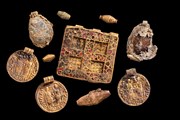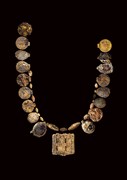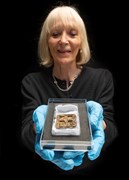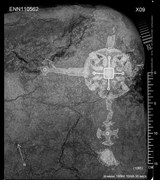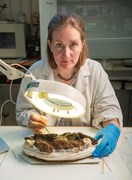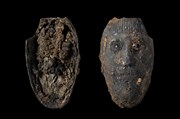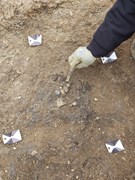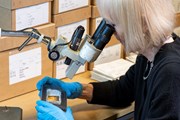
06 Dec 2022
“Once-in-a-lifetime” 1,300-year-old gold and gemstone necklace discovered within internationally significant female burial
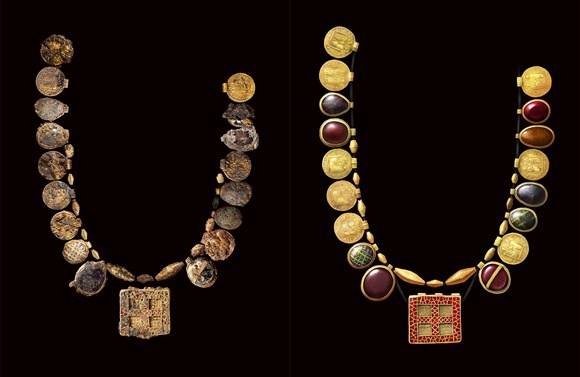
- Extraordinary necklace made of gold, garnets and semi-precious stones found by archaeologists from MOLA working in Northamptonshire
- The necklace, dated to 630 – 670 AD, is part of an elite female burial containing other intriguing grave goods that are still being investigated
- Experts believe this is the most significant Early Medieval female burial ever discovered in Britain, and therefore has national and international importance
- The finds will be featured on BBC Two’s Digging for Britain in January 2023, with Professor Alice Roberts getting a behind-the-scenes look at ongoing conservation work
Archaeologists from MOLA (Museum of London Archaeology) have uncovered an astonishing 1,300-year-old necklace in Northamptonshire. The discovery was made during excavations that took place ahead of a Vistry Group housing development, supported by Archaeological Consultants, RPS.
This necklace is the richest of its type ever uncovered in Britain with at least a staggering 30 pendants and beads made of Roman coins, gold, garnets, glass and semi-precious stones. It was found as part of a high-status female burial containing other intriguing grave goods that are still being investigated. The collection of finds has been dubbed the ‘Harpole Treasure’, based on the name of the local parish. Experts believe this is the most significant female burial from the era ever discovered in Britain.
MOLA Site Supervisor, Levente-Bence Balázs, who led a team of 5 that made the discovery says:
“When the first glints of gold started to emerge from the soil we knew this was something significant. However, we didn’t quite realise how special this was going to be. We are lucky to be able to use modern methods of analysis on the finds and surrounding burial to gain a much deeper insight into the life of this person and their final rites.”
A rectangular pendant with a cross motif forms the centrepiece of the necklace and is the largest and most intricate element. Made of red garnets set in gold, MOLA specialists believe it was originally half of a hinged clasp before it was re-used.
The burial also contained two decorated pots and a shallow copper dish. However, x-rays taken on blocks of soil lifted from the grave revealed a further tantalising find - a striking and elaborately decorated cross, featuring highly unusual depictions of human faces cast in silver. The soil blocks are currently being micro-excavated by MOLA Conservators, but this large and ornate piece suggests the woman may have been an early Christian leader.
The skeleton itself has fully decomposed (with the exception of tiny fragments of tooth enamel). However, the combination of grave goods suggest this was a very devout high status woman such as an abbess, royalty, or perhaps even both.
RPS Archaeology Consultant Simon Mortimer says:
“This find is truly a once-in-a-lifetime discovery – the sort of thing you read about in textbooks and not something you expect to see coming out of the ground in front of you. It shows the fundamental value of developer-funded archaeology. Vistry's planned development provided a unique opportunity to investigate this site. Had they not funded this work this remarkable burial may never have been found.”
Painstaking work is being undertaken by MOLA Conservators to examine and conserve the finds. This includes identifying and recording traces of organic remains within the burial and on the surface of the artefacts. It is possible the deceased was placed on a bed within the grave and traces of soft furnishings may be found. Analysis could also detect residues that show how artefacts were used in life or in the burial ritual.
Surprisingly, the area surrounding the elite burial was completely unremarkable. One other burial was present nearby but did not contain any high-status grave goods nor has been firmly dated. Having surveyed the entire site, archaeologists are confident there is nothing else to find.
A handful of similar necklaces from this time have previously been discovered in other regions of England, but none are as ornate as Harpole. The closest parallel is the Desborough necklace, found in Northamptonshire in 1876 and now in the British Museum’s collections.
Daniel Oliver, Regional Technical Director at Vistry West Midlands says:
“Vistry are pleased to confirm that these internationally important artefacts will be gifted to the nation and any rights to the Treasure have been waived. We are very conscious of the legacy that we leave amongst the communities that we build. Having personally seen this Treasure on site I couldn’t be more excited to see how much more has been learned already – it is amazing.”
The Harpole Treasure will be featured in BBC Two’s Digging for Britain, where Professor Alice Roberts will be getting an exclusive look at this extraordinary find and delving deeper into the ongoing conservation and analysis. The new series of Digging for Britain starts on BBC Two in early January 2023.
Liz Mordue, Archaeological Advisor for West Northamptonshire Council concludes:
“This is an exciting find which will shed considerable light on the significance of Northamptonshire in the Saxon period. It also serves as a reminder of the importance of archaeology in the planning and development process.”
Contact Information
Museum of London Archaeology Media Office
media@mola.org.uk
Notes to editors
Interviews available upon request.
Early Medieval period timeline
- 410 AD: the Roman rule of Britain officially ends
- 5th – 6th centuries: people from modern day Germany, southern Scandinavia and The Netherlands settle in southern and eastern Britain
- Late 6th – 7th centuries: Christianity gradually spreads across southern and eastern Britain and starts to appear in elite burials
- 640 AD – 680 AD: the Harpole Treasure, a high-status burial, is buried in Northamptonshire
- 793 AD: a Viking raid on the monastery at Lindisfarne marks the start of Viking raids on Britain
- 899 AD: King Alfred the Great dies
- 1066 AD: William the Conqueror defeats Harold and becomes King of England, ending the Early Medieval period
Timeline of other famous burials and discoveries
- 575 AD - 605 AD: Prittlewell Prince laid to rest in earliest known post-Roman Christian burial in Anglo-Saxon England
- 620 AD - 630 AD: famous Great Ship Burial at Sutton Hoo
- 630 AD – 670 AD: the Harpole Treasure, a high-status burial, is buried in Northamptonshire
- 650 AD – 675 AD: Staffordshire hoard buried
Treasury Act and valuation
The burial is subject to the Treasure Act and was reported to the Coroner as potential Treasure by the local Finds Liaison Officer. The finds are now going through the normal legal process. Finds declared a ‘Treasure’ would usually be valued by the Treasure Valuation Committee. However, in this case the site archive will be donated and therefore may not need to be put through a valuation process.
For comparison, a contemporary gold and garnet pendent known as the ‘Winfarthing pendant’ was discovered in Norfolk in 2014 and valued at £145,000.
About Vistry Group:
Vistry Group is uniquely positioned to lead the way in the UK housing market with a countercyclical business model featuring Vistry Housebuilding and Vistry Partnerships.
We have an unmatched portfolio of brands – including Bovis Homes and Linden Homes – with rich histories and strong reputations. We are proud of our 5-Star HBF customer satisfaction rating as we deliver on our purpose of developing sustainable homes and communities across all sectors of the UK housing market. Our key asset is our people – around 3,000 of them across the country – who are committed to doing the right thing and living our values of integrity, caring and quality, ensuring we put our customers and clients at the centre of everything we do. For more information, visit www.vistrygroup.co.uk.
About RPS:
RPS is a leading global professional services firm of 5,000 consultants and service providers. Operating in 125 countries, working across six continents they define, design and manage projects that create shared value to a complex, urbanising and resource-scarce world. Delivering a broad range of services, RPS uses deep expertise to solve problems that matter; including pragmatic advice to ensure the optimal balance between protecting nationally-important heritage and enabling sensitive development. Learn more at www.rpsgroup.com.
About MOLA
MOLA is an experienced and innovative archaeological and built heritage practice, Independent Research Organisation, and charity. With over 350 staff working across England, MOLA has been providing independent, professional heritage advice and services for over 50 years. Find out more at mola.org.uk, on Twitter, Facebook and LinkedIn.


